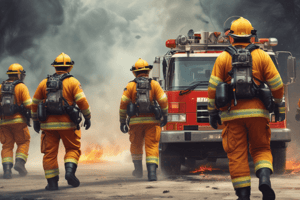Podcast
Questions and Answers
What is the primary strategic consideration in firefighting operations?
What is the primary strategic consideration in firefighting operations?
- None of the above
- Property conservation
- Extinguishment
- Life safety (correct)
What is the purpose of an incident action plan?
What is the purpose of an incident action plan?
- To ensure effective operations (correct)
- To assign units to complete tasks
- To make offensive/defensive strategy decisions
- To categorize tactical objectives
What is the basis for offensive/defensive strategy decision-making?
What is the basis for offensive/defensive strategy decision-making?
- Life safety
- Property conservation
- Risk-versus-benefit analysis (correct)
- None of the above
What is the operational priority and tactical objective in firefighting operations?
What is the operational priority and tactical objective in firefighting operations?
What should be considered when developing an incident action plan?
What should be considered when developing an incident action plan?
What governs the entire operation in a fire incident?
What governs the entire operation in a fire incident?
What is the purpose of written incident action plans?
What is the purpose of written incident action plans?
What is necessary to understand the building's construction?
What is necessary to understand the building's construction?
What should be provided before venting the roof of a lightweight construction building?
What should be provided before venting the roof of a lightweight construction building?
What is the risk associated with any offensive operation?
What is the risk associated with any offensive operation?
What type of construction is modern residential buildings made up of?
What type of construction is modern residential buildings made up of?
What tool is generally considered a defensive tool but can be used to support rescue efforts in large, complex structures?
What tool is generally considered a defensive tool but can be used to support rescue efforts in large, complex structures?
Flashcards are hidden until you start studying
Study Notes
- An incident action plan is necessary for effective operations.
- Offensive/defensive strategy decision is based on risk-versus-benefit analysis.
- Tactical decisions and task assignments are based on the overall strategy.
- The primary strategic considerations are life safety, extinguishment, and property conservation.
- Extinguishment is both an operational priority and a tactical objective.
- When developing an incident action plan, it is best to categorize tactical objectives in terms of their relative importance as primary and secondary objectives.
- Structural conditions bear heavily on the offensive/defensive decision.
- The IC must consider what will be needed to conduct an offensive attack early in the plan development process.
- Resources that are required to fight a fire offensively are different from those needed for a defensive battle.
- Figure 3-1 charts time and resources versus occupant probability of survival in terms of structural stability, temperature, and smoke layer.
- The offensive/defensive decision governs the entire operation in a fire incident.
- Exterior hose streams can be used to soften the target prior to making entry for an offensive attack.
- Master streams are generally considered defensive tools but can be used to support rescue efforts in large, complex structures.
- The IC sets the objectives, decides on the tactics necessary to achieve objectives, and assigns units to complete the tasks associated with each objective.
- Written incident action plans are required when an incident extends past a single operational period or if a unified command is established.
- The incident action plan should cover all tactical and support activities required during the operational period.
- The IC must follow up and request status reports after making assignments.
- Fires in the home make up the vast majority of fires.
- The process used to develop an incident action plan for a small residential fire is the same as that used for a large and complex fire.
- There is a risk associated with any offensive operation, but the risk to firefighters is usually less in a single-family dwelling than it would be in a larger, more complex occupancy.
- Modern residential buildings have lightweight construction.
- The lightweight construction is not as sturdy as older buildings.
- The lightweight construction is made up of truss roof and engineered floor construction.
- In a fire, extreme caution should be used if the IC decides to vent the roof.
- A stable platform should be provided before venting the roof.
- Aerial, elevated platform, or roof ladder can be used to provide a stable platform.
- The lightweight construction can collapse more quickly than older buildings.
- Pre-planning is necessary to understand the building's construction.
- Firefighters should be aware of the potential hazards of lightweight construction.
- The involvement of lightweight construction should be considered when developing a firefighting strategy.
Studying That Suits You
Use AI to generate personalized quizzes and flashcards to suit your learning preferences.



